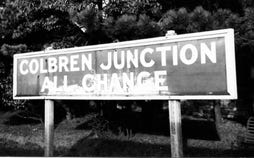Please note that this page is being updated,
hence some gaps.
Our families came from a core of close-knit, usually adjoining farms and homesteads near to today’s village of Banwen. Some of the farm names survive, especially the older ones; others have disappeared. The ten-yearly census, available from 1841, gives us neat snapshots of how these farms were occupied over the years and how their inhabitants inevitably became interconnected through marriage.
TIR BACH 1841: Richard Jones, 50, Ann Jones, 45 and children William 20, Margaret 8, Jacob 6, Elizabeth 4, Daniel. By 1851 this property has either been renamed on the census or has disappeared. Richard Jones and remaining family live in one of the cluster of settlements known as “Waen-Marchog”.
On the early map, this is shown as a discrete settlement, probably a farmhouse, and it is identified as such in the 1841 census. In later censuses it seems to be swallowed up by the Maesmarchog colliery but still does appear to give its name to this general area, although the name is no longer used today. The original farm or smallholding probably became one of the “Banwen colliery houses”[1], and one of “several small cottages on the surface of Onllwyn No. 3 Colliery.” If we try and recreate in 1851 the same round the census enumerator took in 1841, there is no comparable establishment for the same Tir Bach in 1841. However in 1851, one entry adjacent to Pantyddrainen shows “3 houses unoccupied” and we can also see the addition of an “Engine House”, next to which the enumerator also records “6 houses uninhabited”. The lonely moor had never seen this level of activity and change. Unfortunately then for our Jones family, while practically all of the other old farm settlements are easily traceable for over two hundred years, Tir Bach disappeared in its own right quite quickly. One very likely possibility is that it was demolished to make way for the colliery workings, as it sat right on top of what was to come, and thus might have given its name to the little industrial hamlet that developed around the colliery.
PANTYDDRAIEN This name has also disappeared and the last reference to it in the area refers to the pub at the bottom of Banwen Village, which was itself demolished in 2003. Pantyddrainen farm was slightly below Tir Bach, and just above today’s DOVE workshop. “This old farm and two cottages were all under one roof in the form of a terrace” which suggests a typical Welsh longhouse form of construction, but it was “poor land, mountain and marsh, only fit for grazing sheep and ponies.” (Lewis, 1977)
1841: William Williams, Farmer, his wife and eight children are shown there.
1851: William Williams, Farmer, his wife and ten children are shown there. Two settlements away, a little further down the hill northwards, another family is also recorded at “Pantyddrainen”: Morgan Evans, widower, his son-in-law William Jones, daughter Ann and their five children. William Jones (1818-c.1860) married Ann Evans at Crynant Chapel (established church) on the 29th April 1843. At this point, William’s residence was recorded as Lamb and Flag (Glynneath). His father was Hugh Jones, a carpenter. William’s occupation at marriage was stated as Miller No direct connections are yet evident between William Jones, and, say, the Richard Jones family from Tir Bach, but links between these families would be established later, especially through Morgan Jones (b. 1843).
1861: Morgan Evans, son of Morgan Evans above, his wife Jennet, and their two children, unsurprisingly named Morgan and Jennet. From 1851, William Williams had died in 1854. Previous resident William Jones had died before 1861 and his family, headed by his widow Ann with four children between 17 and 4, are now living at Taicerrig, towards Ystradfelte. A son Morgan, would later farm at Camnant.
1891: Morgan Evans, 54 his wife Jennet 55, and their five children.
Morgan Jones, 47, and Hannah Jones, 48, and children: William, Thomas, Mary and Ann. Morgan Jones is the son of William Jones & Ann Evans of Pantyddrainen.
TIR BACH Y CAMNANT Earlier maps and records refer to this as “Tir Bach”, some as “Tir Bach y Camnant” and later ones just as “Camnant” or as what is now known as Camnant Farm. The Camnant was a small brook which originated in the Banwen bog and fed the Pyrddin. 1841 : John Hopkin, 25 and Gwenllian Hopkin, 25 (no family connections as yet). By 1848, was tenanted by Llewellyn Jones (no connection).
1851: Jane Jones, 45, widow and children Thomas 15; Jenkin 11; John 9; Mary 6; Hannah 4; Howell (no family connection yet established).
1861: Howell Powell, 45, his wife Eleanor and 5 children. One of these was John Powell, now aged 8, who would go on to marry now 9 year-old Mary Jones, of the William Jones family, Ynysdomlydd,in 1873.
1871: Howell Powell, 56, wife Eleanor 56; Rees Powell 11; and son John Powell 18. He would marry Mary Jones, daughter of William Jones, originally of Ynysdomlydd.
1911: William Jones (42) and Eleanor Jones (33) and four children: Benjamin 5, Mary 4, Gwilym 2 and Hannah 2 mths. William Jones was the son of Morgan and Hannah Jones, also of Camnant. While no direct connection to this Jones family has been made, connections through marriage would be mad by future descendants: e.g. daughter Hannah shown here would later (1938) marry Thomas Lewis of Coelbren Farm, whose mother, Gwenllian Jones, was daughter of Richard Jones, Toncastell.
“Morgan Jones built a house (Bryngolau where I was born) on his land where he lived when William and family moved to Camnant Farm. Sometime in the 10-20s a tramp shot him outside Bryngolau, however Morgan survived and the tramp imprisoned.” (E Lewis, email to author Oct. 2016)
TONCASTELL 1841: Rees Benjamin, 55 and sons David 15; Rees 6 and William 3. The Benjamins would be connected to the Jones family in later generations.
1861: David Benjamin, 38, his wife Magdalen, their three children and David’s brother Rees, 26. One of these children, Mary, would later marry Richard Jones, of the William Jones family, Ynysdomyldd, in 1870.
1871: David Benjamin, widower, 48; children William 16; Rees 14; also son-in-law Richard Jones, 23; his wife Mary Jones 20 (David Benjamin’s daughter); and their son David, 5 months.
DYSGWLFA 1841: Meredith Davies, 55; Jennet Davies 50 and children John 20; Gwenllian 15. Gwenllian would marry William Jones from Tir Bach in 1843. 1851: Meredith Davies, 65; Jennet Davies, 65 and children John 34.
YNYSDOMLYDD By 1848, was tenanted by William Jones and Gwenllian Jones, who had married in 1843.
1851: From at least 1848, was tenanted by William Jones and Gwenllian Jones (married in 1843): here shown with children Jennet 7; Ann 5; Richard 4; Margaret 1. Eldest daughter Jennet would later marry Samuel Bryant from the adjoining Tonplanwidd farm.
1861: William Jones, 41, his wife Gwenllian (Davies) and six children: Ann 15, Margaret 11, Mary 9, Meredith 7, Elizabeth 4 and Joan 2
1871: By this time William Jones and his family had moved to Corsllwyn Coch, just southeast of Coelbren village.
1891: John James, 30, Mary James (30) and children Morgan, John, Ann and Richard.
BRYNCYLOCA 1861: Samuel Bryant, 50 his wife Mary (Jones), and their 6 children. One of their sons, also Samuel, would marry Jennet Jones, of the William Jones family, Ynysdomyldd, in 1869. A daughter, Mary Bryant, would marry Owen Jones of Onllwyn, in 1882.
1891: James and Sarah Pitt: no further family connection

